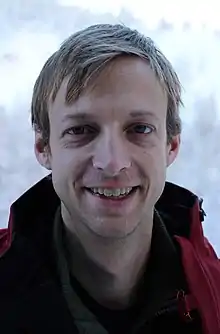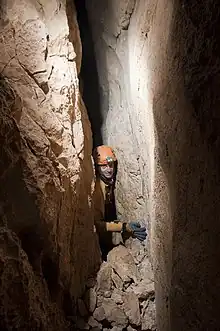Matt Covington
Matthew D. Covington (born May 15, 1980 in Fort Worth) is an American speleologist, most known for his work in hydrogeology and geomorphology,[1] especially in the field of mathematical modeling of karst systems, as well as by his contribution to Cueva Chevé project in Mexico, since 1999.[2][3]
Matt Covington | |
|---|---|
 at Vršič Pass in 2014 | |
| Born | May 15, 1980 |
| Alma mater | |
| Years active | 1998–present |
| Known for | speleology, deep cave projects |
| Spouse | Elizabeth (married 2002) |
| Children | 2 |
| Website | http://www.speleophysics.com/ |
Early life, education and career
He was born in Fort Worth, his father is an electrical engineer, and his mother is a middle school teacher. After high school in Fayetteville (1998) he graduated in physics (The Trebuchet: Physics, numerics, and connections to millennia of human activity) and philosophy (Quantum mechanics and libertarian free will) at the University of Arkansas in 2002.[4] In 2008 he completed his doctoral study in theoretical astrophysics at the University of California in Santa Cruz, with the thesis: The production and evolution of scaling laws via galaxy merging.[5] After PhD he pursued a postdoc study with a grant by NSF. In 2010 he completed it and started another postdoc in Postojna, Slovenia, also supported by NSF.[6]
Early caving
Covington grew up in a caving area, the Ozark Mountains, and first visited a cave at the age of 6. He became quite interested in caving at about 14, at 15 he read the National Geographic report about Bill Stone's expedition to Huautla cave (NG, September 1995) which was decisive for his later caving, and at 16 he joined the Boston Mountain Grotto in Fayetteville. At first it was recreational caving in the neighbourhood, the first expedition he took part in was to the Tongass National Forest in Southeast Alaska in the summer of 1999.[7][8]
Oaxaca caves
In 2004 he took part in Bill Stone's expedition to Cueva Chevé area in Mexico, when J2 cave was discovered. He was involved in all of the subsequent expeditions to Cueva J2 (2005, 2006, 2009, 2010, 2013)[9] and co-led the 2010 expedition with Marcin Gala and Jon Lillestolen.[10] In 2009 he dove through the sump in the bottom of J2 with Marcin Gala and established the first camp on the far side of the sump.[11] He also participated in the expeditions to Cueva Chevé and Peña Negra cave in 2016.
He also joined an expedition to the Huautla area to Cueva de Rio Iglesia during 2007. During this expedition, Matt and Yuri Schwartz found a connection between Cueva de Rio Iglesia and the rest of Sistema Huautla.[12] The previous team that had explored to the bottom of Rio Iglesia in 1967 had been stopped by a sand plug. When Matt and Yuri reached the bottom of the cave they found that the plug had been opened and the passage quickly lead to a connection with Cueva de San Augustin.[13]

Julian Alps caves
From August 2010 to August 2012, Covington worked as a postdoc at the Karst Research Institute in Postojna, Slovenia, supported by a National Science Foundation International Research Fellowship. While there, he worked with Franci Gabrovšek,[14] who had a similar academic background in that he was a physicist by training but was using physics to understand processes occurring in caves. Covington read the book "Processes of Speleogenesis: A modeling approach",[15] co-authored by Gabrovšek, and met Gabrovšek at the Karst Waters Institute "Future directions in karst research" conference in San Antonio, TX. During this period, Covington joined DZRJL, Ljubljana Cave Exploration Society, and began exploration of caves in Slovenia.[16][17] He discovered a new caving area on Pokljuka near the mountain Viševnik.[18]
The first cave discovered on Pokljuka was Evklidova piščal (pron. Evcledovah peshchal, translated as Euclid's flute), which Covington found as a blowing hole in the fall of 2010.[19] This was the first major cave found on the Pokljuka plateau aside from Medvedova konta. After initial exploration in Evklidova piščal the DZRJL began systematic exploration of the area for new caves. Many small caves were found. In the summer of 2013 Covington led an international expedition to the area in collaboration with DZRJL. During this time the team found another promising cave, Platonovo šepetanje (pron. Plahtonovoh shepetanya, translated as Plato's whisper) cave. Later that fall, cavers from DZRJL found the next large cave, Trubarjev dah (pron. Troobaryev dah, translated as Trubar's breath). The caves in this area are relatively complex and exploration continues on many fronts.[20] Trubarjev dah, Platonovo šepetanje and Romeo cave, the entrance of which is located above the two, have been connected to a system close to 10 km in length and over 670 m deep.[16] The team is still searching for a connection with Evklidova piščal, Covington joined the effort at the end of 2019.[21]
_at_Mt._Kanin.jpg.webp)
Given his experience with diving in deep vertical caves, Covington was asked by DZRJL member Mitja Prelovšek to conduct an initial exploration dive into the sump at the bottom of Renejevo brezno on Mt. Kanin.[22] Covington was relatively inexperienced in exploration diving and agreed to conduct a very short reconnaissance dive. He had only a 5 mm wetsuit and planned for a maximum dive duration of 20 minutes. After 30 m of horizontal continuation at a depth of approximately 10 meters, he saw an airbell above and ascended into it. There was no obvious continuation within the pocket above and at this point he decided to finish the dive and returned to Copacabana. Covington's dive computer read a water temperature of 0.5 degrees C. The main tunnel continued to descend, but Covington did not have the time to continue exploration there.[22]
Other pursuits
Covington has also participated in cave exploration expeditions to Peru (2004),[23] Sumatra (2000), the Purificacion area of Northern Mexico (2000, 2001),[2] Grotte des Chamois in France (2011),[24] Lukina jama in Croatia (2011),[25] to caves in Wulong County China (2012),[26] to glacier caves of Nepal and Svalbard.[27]
References
- Luhmann, Andrew J.; Covington, Matthew; Alexander, Scott C.; Chai, Su Yi; Schwartz, Benjamin F; Groten, Joel; Alexander Jr., E. Calvin (July 2012). "Comparing conservative and nonconservative tracers in Karst and using them to estimate flow path geometry". Journal of Hydrology: 448–449, 201–211. Retrieved 19 December 2019.
- "J2 2009 Personnel". United States Deep Caving Team. 2009. Retrieved 3 February 2020.
- "Sistema Cheve 2018 Personnel". United States Deep Caving Team. 2018. Retrieved 3 February 2020.
- Covington, Matt (February 2019). "Matthew D. Covington" (PDF). Covington Research Group. Retrieved 19 December 2019.
- Covington, Matthew D. (September 2008). The production and evolution of scaling laws via galaxy merging (PDF) (PhD). University of California, Santa Cruz. Retrieved 14 December 2019.
- "Dr. Matt Covington". University of Arkansas. Retrieved 19 December 2019.
- Bilger, Burkhard (14 April 2014). "In Deep / The dark and dangerous world of extreme cavers". The New Yorker. Retrieved 17 December 2019.
- Covington, Matt (4 January 2011). High and Low Places in Lechuguilla Cave [Višine, globine in ožine jame Lechuguilla] (Speech). Predavanja DZRJL / DZRJL Lectures. Ljubljana, Slovenia. Retrieved 18 December 2019.
- "J2 2013 Personnel". United States Deep Caving Team. 2013. Retrieved 4 February 2020.
- Covington, Matt (June 2010). "Sistema J2–last Bash: the 2010 J2 expedition" (PDF). AMCS News. Association for Mexican Cave Studies (33): 39–44. Retrieved 4 February 2020.
- Ornes, Stephen (1 October 2015). "Unchartered underground". Physics World. Retrieved 19 December 2019.
- Covington, Matt; Minton, Mark (August 2008). "How to Make a Major Cave Connection in Two Weeks". NSS News. National Speleological Society: 8–19.
- Steele, C. William; Smith Jr., James H. (2012). "Sistema Huautla, Mexico". In White, William B.; C ulver, David C. (eds.). Encyclopedia of Caves. Encyclopedia of Caves (Second Edition). Richmond Hill, Ontario: Academic Press. pp. 712–718. doi:10.1016/B978-0-12-383832-2.00016-5. ISBN 9780123838339.
- Covington, Matt; Gabrovšek, Franci (2013). "A theoretical framework for understanding the relative importance of chemical and mechanical erosion processes in cave streams" (PDF). Proceedings of the 16th International Speleological Congress. Brno, Czech Republic: Union Internationale de Spéléologie. p. 346. ISBN 978-80-87857-09-0. Retrieved 3 February 2020.
- Dreybrodt, Wolfgang; Gabrovšek, Franci; Romanov, Douchko (2005). Processes of Speleogenessis. A modeling approach. Postojna: Karst Research Institute. ISBN 961-6500-91-0.
- Perne, Matija; Jakopin, Primož (6 September 2015). "Pokljuka Area". DZRJL - Ljubljana Cave Exploration Society. Retrieved 4 February 2020.
- Di Batista, Matic (16 June 2014). "Raziskovanje kraških jam" [Karst Caves Exploration] (in Slovenian). gore-ljudje / mountains-people. Retrieved 18 December 2019.
- Fidler Pompe, Jerneja (May 26, 2017). "The most beautiful mountain for everyone: Viševnik". Exploring Slovenia. Retrieved 3 February 2020.
- Covington, Matt; Di Batista, Matic (2013). "Discovery and exploration of Evklidova piščal, Julian Alps, Slovenia" (PDF). Proceedings of the 16th International Speleological Congress. Brno, Czech Republic: Union Internationale de Spéléologie. p. 58. ISBN 978-80-87857-09-0. Retrieved 3 February 2020.
- Elor, Gilly (January 2015). "January 2014 Expedition to Platonovo šepetanje". NSS News. National Speleological Society: 18–20.
- Covington, Matt (11 December 2019). "Evklid goes!". DZRJL - Ljubljana Cave Exploration Society. Retrieved 6 February 2020.
- Prelovšek, Mitja (December 2011). "Potop v končnem sifonu Renejeva brezna na globini -1.242 m" [Diving in the terminal siphon of Renejevo brezno cave, at the depth of -1.242 m]. Jamar (in Slovenian). No. 8. Ljubljana: Jamarska zveza Slovenije. p. 6. Retrieved 3 February 2020.
- Covington, Matt (December 2005). "Caving in the Peruvian Andes: 2004 Expedition" (PDF). Journal of Caving and Karst Studies. National Speleological Society: 194. ISSN 1090-6924. Retrieved 3 February 2020.
- "Chamois 2011: International Exploration Camp". Caving News. August 26, 2011. Retrieved 3 February 2020.
- White, Bruce; Warner, Doug (February 2012). "Drama in Lukina jama" (PDF). NSS News. National Speleological Society: 4–13. Retrieved 3 February 2020.
- Covington, Matt (8 May 2012). Misty Mountains and Giant Caves: Recent Exploration in China [Meglene gore in orjaške jame: nedavne raziskave na Kitajskem] (Speech). Predavanja DZRJL / DZRJL Lectures. Ljubljana, Slovenia. Retrieved 18 December 2019.
- Covington, Matt; Gulley, Jason; Ochel, David (2013). "Glacier cave expeditions 2012: Nepal and Svalbard" (PDF). Proceedings of the 16th International Speleological Congress. Brno, Czech Republic: Union Internationale de Spéléologie. pp. 59–61. ISBN 978-80-87857-09-0. Retrieved 3 February 2020.